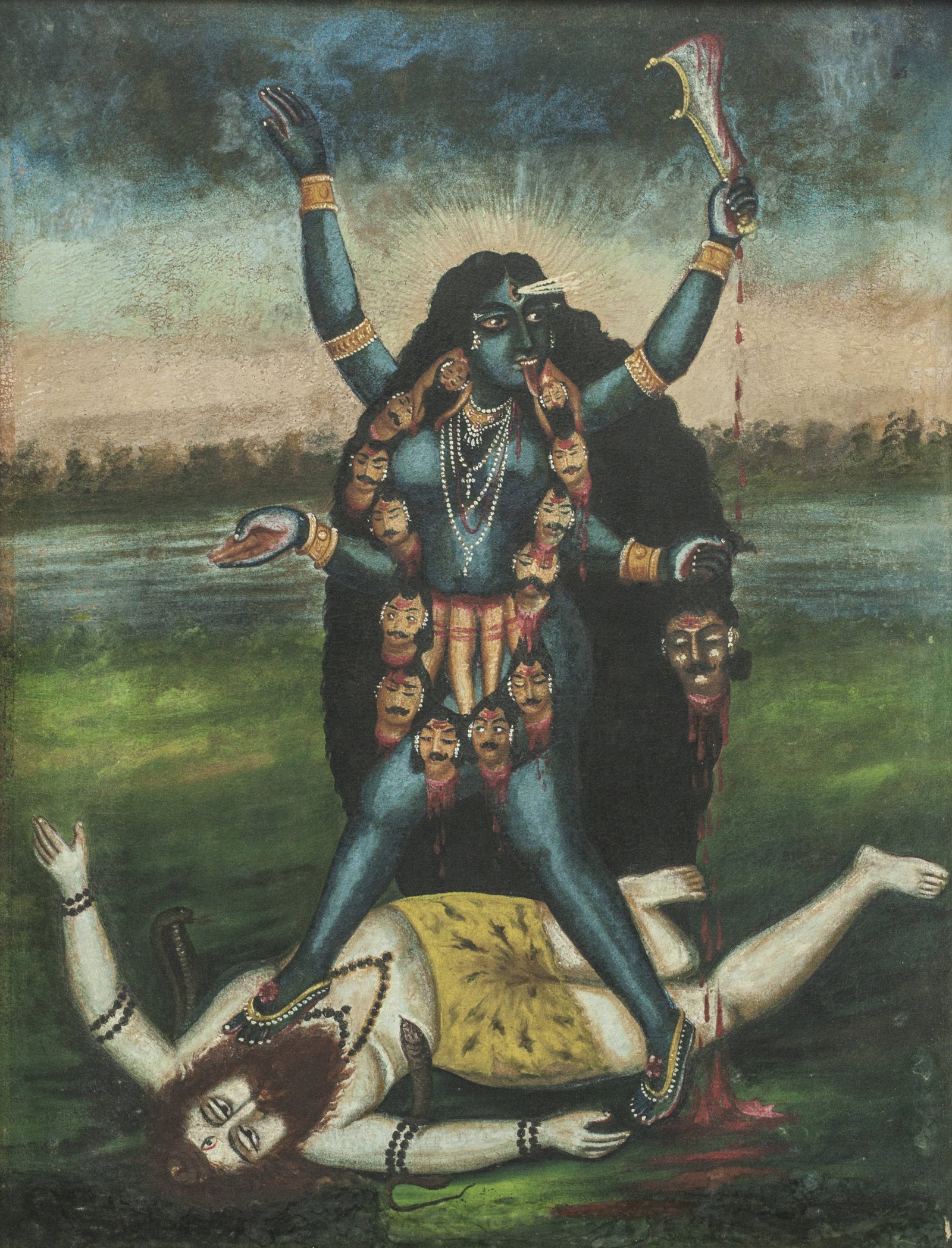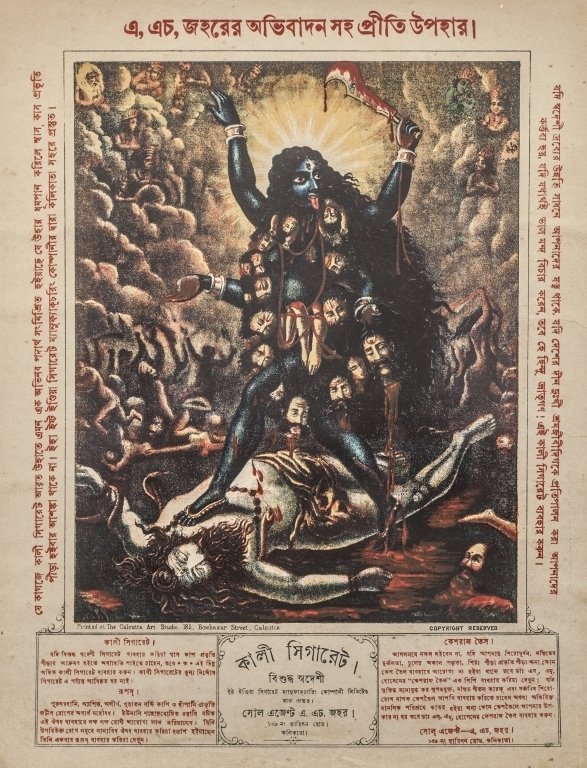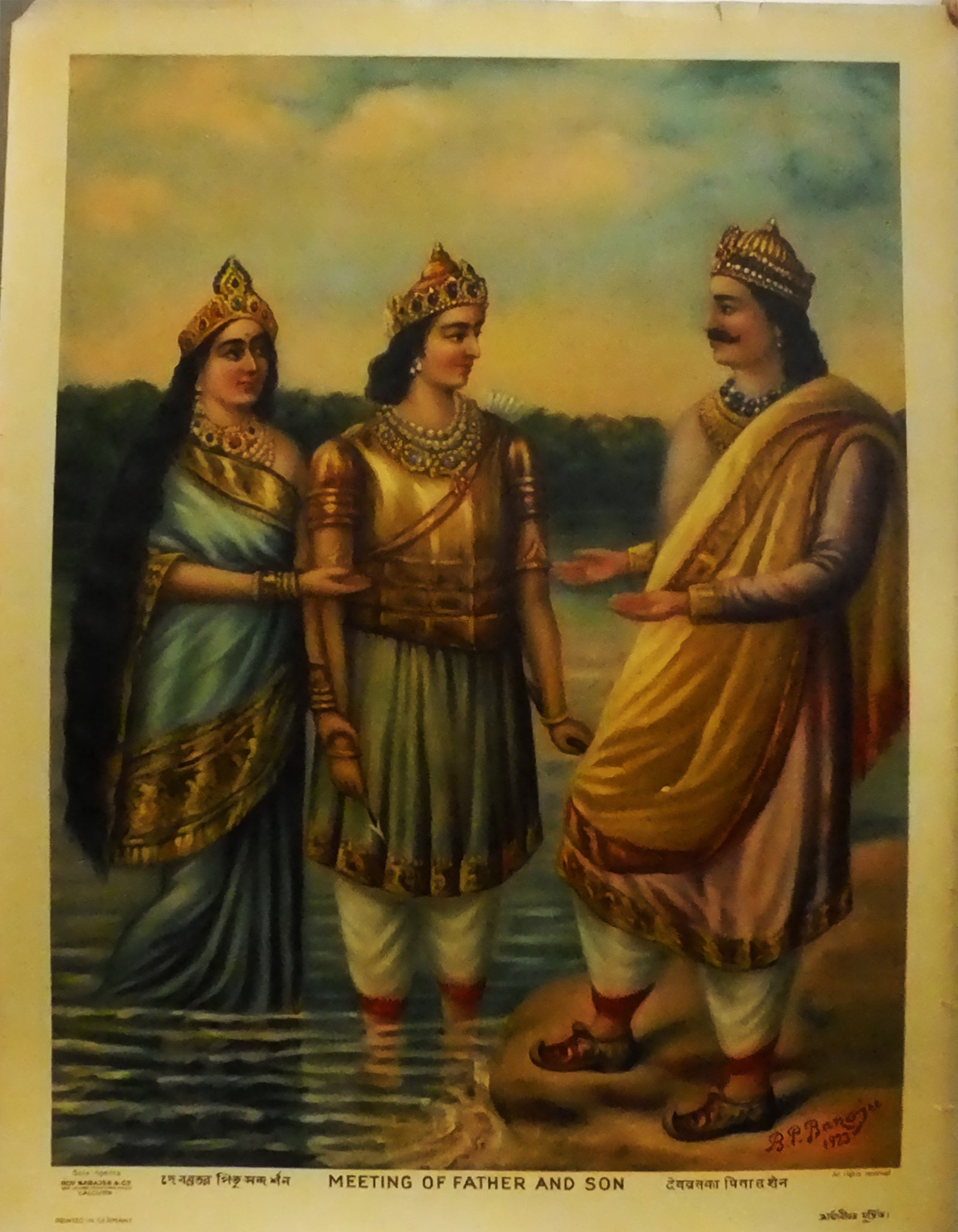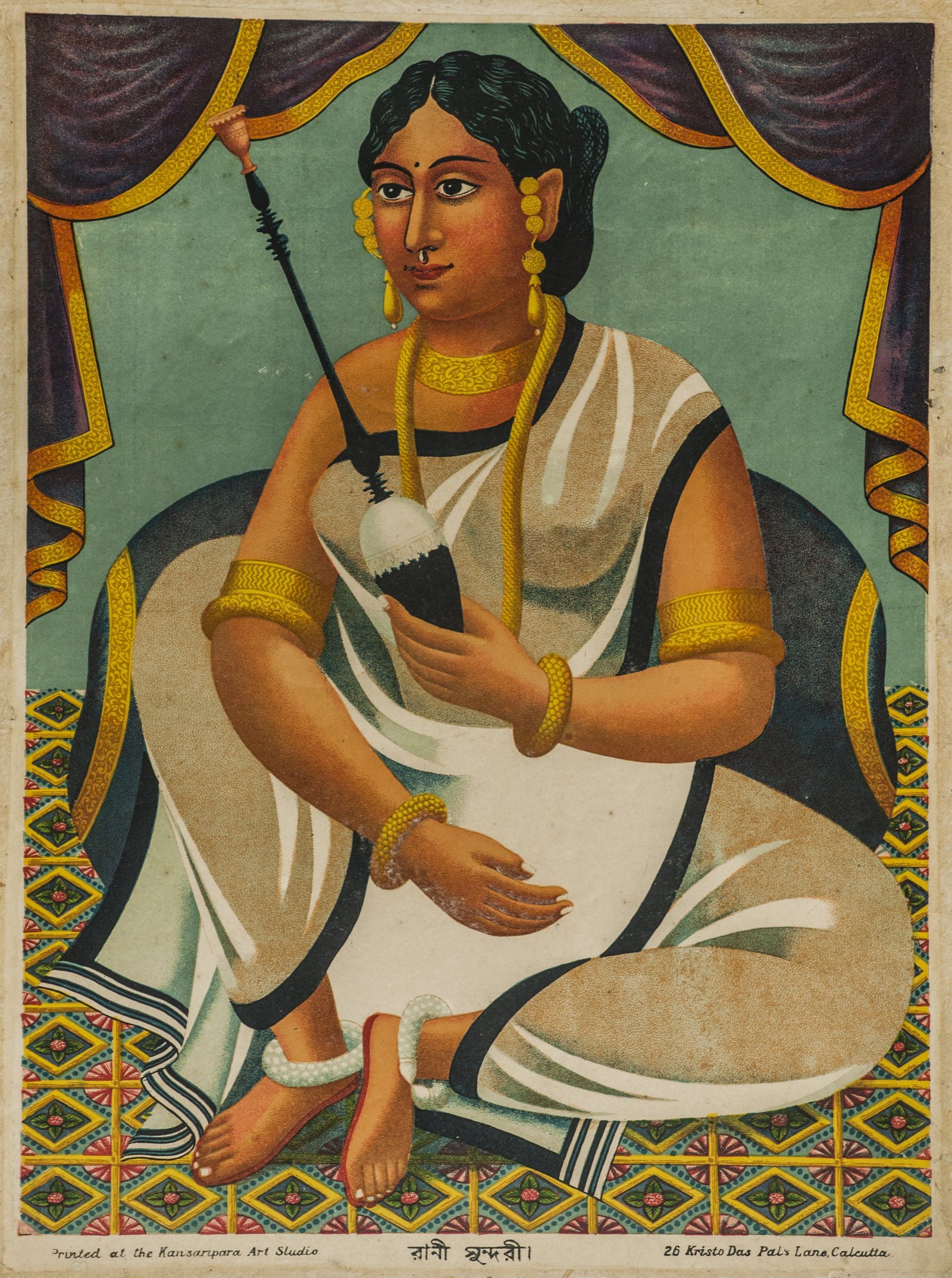
19th Century Swadeshi Art: Paintings & Prints
August 28 – October 15, 2017 at Akar Prakar, Delhi
The Mughal era, famous for its art and architecture, was coming to an end and the French and Portuguese had established their trading outposts during the time of Aurangzeb, the last great Mughal. The European foreigners, like the Mughals, had a lavish lifestyle with art, especially paintings, forming an important aspect of it. Again, like the Mughals, these traders used local artists to satisfy their aesthetic sense and in places like Chinsurah, Chandarnagar and Serampore, these artists were commissioned for portrait paintings.
From the mid 18th to mid 19th century, many local artists were patronised by the Company’s bureaucrats and officers. To follow the orders of their patrons these artists would paint the lords and ladies of the household, their pets and the houses as well. During this time, many of these artists became familiar with the landscape paintings of the European painters. Some of these local artists, Sheikh Mansoor Ali of Kareya being the one whose name crops up often, imitated the Europeans and the paintings came to be known as belonging to the Company School. Some of these paintings are called ‘Dutch Bengal’ or ‘French Bengal’ according to their antecedents.
Though the foreigners were pleased by the efforts of the local artists, the latter’s sense of perspective or figure left much to be desired. To correct this, an art school was set up in Calcutta (Calcutta School of Art) in 1854 CE to teach the techniques of painting. From 1864, its administration was completely taken over by the government. Mr. Henry Hoover Locke was sent by the British government as Director of the school. He introduced the teaching methodology of South Kensington School of London which followed the Naturalism style of Joshua Reynolds.
The products of this school brought a radical change in the scenario of art in Calcutta from the mid of 19th century, these works are now named, the Pre-Bengal School. These artists also strengthened the base of the Bengal School to come. Both the British rulers and estimable persons of our country started to admit that the artists of this school could form a platform for ‘High Art’.
Pat painting of Kalighat became popular at that time in Calcutta. Everything was depicted through this medium. Mythology, religion, social scandals, and social satire---nothing was beyond the pale of the Potuas. Popularity of this form inspired the wood cut artists of Battala. They also appeared in the market with huge, hand painted, wood cut paintings. Not only this, these artists painted for books and magazines, even panjikas and captured the market. The Potuas took the help of the ‘litho’ print to stay in the competition. The outlines of the pictures would be printed and the potuas would only fill them with colours.
Formal art educated artists of that time were Annadaprasad Bagchi (1849-1905), Shyamacharan Shrimani, Nabakumar Bishwas (1861-1935), Phanibhushan Sen, Krishnachandra Pal, Yogendranath Mukhopadhyay, Bamapada Bandyopadhyay (1851-1932), Shashikumar Hem (1869-?), Bhabanicharan Laha (1880-1946) and many others. These artists used to depict perspectives, figures, and landscapes in oil and water colours following the European method. Many portraits, religious paintings and other paintings were also painted by them for personal purposes of the Company officers or native patrons. These paintings were placed beside the European paintings in exhibitions and competitions. Their paintings gained the appreciation from intellectuals and art connoisseurs of locally as well as from every corner of the country.
Annadaprasad Bagchi was the most advanced, talented and expert in all mediums in this group of artists. He was given the responsibility of teaching in his alma mater after completing his course at the Art School. In 1878, he established Calcutta Art Studio near Bowbazar with Nabakumar Biswas, Phanibhushan Sen and Yogendranath Mukhopadhyay, fellow artists at Art School, to make realistic paintings more popular and easily available. In those days, few could afford to buy the oil paintings. They decided to print in ‘litho’ besides paint in oil and water colour, so that they would be within reach of the people. (The litho prints of the paintings of Raja Ravi Varma were yet to come from Western India.)
It can be said that due to the cheaper Battala literature, the small ‘litho’ studios of Kansaripara and Chorbagan started to print many paintings. Painters of Art School were also attached to these studios. But the painters of Calcutta Art Studio specifically never painted or printed any cheap paintings for the market. Rather, their portfolio had patriotic paintings besides mythological or religious paintings. Patriots like Surendranath Bandyopadhyay, Keshabchandra Sen, and Swami Vivekananda used to come to the Studio. Mythological or religious paintings of the Studio became very popular and gradually these paintings replaced ‘High Art’ as the top draw. The paintings of Kansaripara and Chorbagan also became popular. Following the market dictates, they also included religious pictures as well as cheap paintings which became popular. The influence of Kalighat pat may be noticed in these paintings. Besides oil paintings, these pictures gave the art of Calcutta an identity of its own.
The oil paintings of Bamapada Bandyopadhyay were printed in ‘oleograph’ from Germany and captured the market of Calcutta. The German printers often failed to maintain the subtleness of another painter, Bamacharan Bandyopadhyay’s paintings. Entering the 20th century, these pictures existed only for three decades. In the mean time, under the leadership of Abanindranath Tagore, the artists of Bengal School introduced Indian art to the world, consequently making it more modern.
Some rare oil, litho and oleograph paintings of the Pre-Bengal School from 19th century are collected here. Most of the time there is no mention of the artist and the period. Hence it is difficult to pinpoint the actual artist and the time. But these paintings help to develop an idea of the nature of the work of the artists and the era of these paintings. At that time, as already mentioned, religious and mythological paintings were more popular. Sometimes, the same painting has been done by different artists.
Besides the paintings, the litho prints and oleographs also reveal the trends of the Pre-Bengal School. The litho prints and oleographs are also the works of the famous artists of that period that prove their artistry. With the paintings of that and later periods, there are the oleographs of Bamapada Bandyopadhyay besides the litho prints of Calcutta Art Studio and Kansaripara Art Studio.
Ashit Paul
Bhairavi | Oil on canvas | 23.25 x 17.75 in | C. 1880
Kamala & Bhairavi | Lithograph on paper (Calcutta Art Studio) | 12 x 16 in | C. 1880
Bhubaneswari | Oil on canvas | 23.25 x 17.25 in | C. 1880
Bhubaneswari & Bagala | Lithograph on paper (Calcutta Art Studio) | 12 x 16 in | C. 1880
Bagala | Oil on canvas | 25.75 x 19 in | C. 1880
Kali | Oil on canvas | 25.75 x 19.25 in | C. 1880
Kali (Advertisement) | Lithograph on paper (Calcutta Art Studio) | 16.25 x 12 in | C. 1885
Kalighater Kali (Kali of Kalighat Temple) | Lithograph on paper (Kansaripara Art Studio) | 8 x 6 in | C. 1900
Shodoshi & Chinnamasta | Lithograph on paper (Calcutta Art Studio) | 12 x 16 in | C. 1880
Dhumavati & Matangi | Lithograph on paper (Calcutta Art Studio) | 12 x 16 in | C. 1880
Sri Durga | Oil on canvas | 35 x 29 in | C. 1930
Dev Gostho (Devi Durga with baby Krishna) | Lithograph on paper (Kansaripara Art Studio) | 14.75 x 11.25 in | C. 1900
Sri Saraswati | Lithograph on paper (Kansaripara Art Studio) | 14.75 x 11.25 in | C. 1900
Sri Saraswati (Advertisement) | Lithograph on paper (Calcutta Art Studio) | 16.25 x 12 in | C. 1885
Krishna Kali | Oil on canvas | 26 x 35.5 in | C. 1880
Krishna Kali | Lithograph on paper (Calcutta Art Studio) | 16 x 20 in | C. 1879
Nikunja Bihar | Oil on canvas | 16.5 x 13 in | C. 1880
Nikunja Bihar | Lithograph on paper (Calcutta Art Studio) | 16.25 x 12 in | C. 1880
Young Sri Chaitanya in front of Guru | Oil on canvas | 36 x 30 in | C. 1900
Gouranger Grihatyag (Gaurango leaving his family) | Lithograph on paper (Kansaripara Art Studio) | 15.75 x 11 in | C. 1900
Nadiabihari Gour Hari (Gouranga of Nadia who also is Krishna as belief by devotees) | Mixed media on board | 19.25 x 15.25 in | C. 1914
Sri Sri Gour Netai (Sri Gouranga and Nityananda) | Lithograph on paper (Kansaripara Art Studio) | 14.75 x 11 in | C. 1900
Gour Sanyas (Gouranga became Sri Chaitanya after aesthetic medicancy) | Lithograph on paper (Calcutta Art Studio) | 16 x 12 in | C. 1888
Sadabhuja Gouranga Avatar & Kali | Lithograph on paper (Calcutta Art Studio) | 12 x 16 in | C. 1880
Devyani rescued from well | Oleograph print from Germany on paper | 26 x 16 in | C. 1925
Meeting of father & son (Debabrata) | Oleograph print from Germany on paper | 20 x 15 in | C. 1923
Kaikeyee & Manthara | Oleograph print from Germany on paper | 20 x 15 in | C. 1906
Arjuna & Urvashi | Oleograph print from Germany on paper | 20 x 15 in | C. 1900
Uttara & Abhimanyu | Oleograph print from Germany on paper | 18.5 x 14.25 in | C. 1898
Manada Sundari | Lithograph on paper (Kansaripara Art Studio) | 15.75 x 11.75 in | C. 1890
Nalini Sundari | Lithograph on paper (Kansaripara Art Studio) | 14.75 x 11 in | C. 1890
Rani Sundari | Lithograph on paper (Kansaripara Art Studio) | 15 x 11 in | C. 1890
About Ashit Paul
Ashit Paul (b. 1950) is an artist and researcher with expertise in 19th century woodcut prints, litho prints and art of early Calcutta. He has many books to his credits such as Woodcut prints of Nineteenth Century Calcutta (Seagull Publication, 1983) and Unis sataker kath khodai shilpi Priyagopal Das (Signet Books, 2013). He has written many articles and edited periodicals like Artist and Samakalin Kolkata. He has documented ‘Native Arts of Chitpur and allied area of Calcutta’ under Lalit Kala Akademi and West Bengal Dance Drama Music and Visual Arts from 2013 to 2015. As an artist he has participated in many National Exhibitions and Triennial India. He was member of the General Council, Lalit Kala Akademi from 2008-2012.































